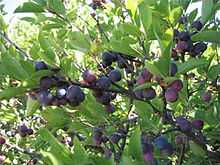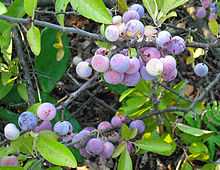Prunus maritima
| Prunus maritima | |
|---|---|
 | |
| Scientific classification | |
| Kingdom: | Plantae |
| (unranked): | Angiosperms |
| (unranked): | Eudicots |
| (unranked): | Rosids |
| Order: | Rosales |
| Family: | Rosaceae |
| Genus: | Prunus |
| Subgenus: | Prunus |
| Section: | Prunocerasus |
| Species: | P. maritima |
| Binomial name | |
| Prunus maritima Marshall | |
| Synonyms[1] | |
| |
Prunus maritima (Beach Plum) is a species of plum native to the East Coast of the United States, from Maine south to Maryland.[2][3] Although sometimes listed as extending to New Brunswick, the species is not known from collections there, and does not appear in the most authoritative works on the flora of that Canadian province.[4]
It is a deciduous shrub, in its natural sand dune habitat growing 1–2 m high, although it can grow larger, up to 4 m tall, when cultivated in gardens. The leaves are alternate, elliptical, 3–7 cm long and 2–4 cm broad, with a sharply serrated margin. They are colored green on top and pale below, becoming showy in the autumn. The flowers are 1-1.5 cm diameter, with five white petals and large yellow anthers. The fruit is an edible drupe 1.5–2 cm diameter in the wild plant.[5][6]
A plant with rounded leaves, of which only a single specimen has ever been found in the wild, has been described as Prunus maritima var. gravesii (Small) G.J.Anderson,[7] though its taxonomic status is questionable, and it may be better considered a cultivar Prunus maritima 'Gravesii'.[8] The original plant, found in Connecticut, died in about 2000, but it is maintained in cultivation from rooted cuttings.[7]
The plant is salt-tolerant and cold-hardy. It prefers the full sun and well-drained soil. It spreads roots by putting out suckers but in coarse soil puts down a tap root. In dunes it is often partly buried in drifting sand. It blooms in mid-May and June. The fruit ripens in August and early September.
The species is endangered in Maine, where it is in serious decline due to commercial development of its beach habitats.[5]
Cultivation and uses
The species is grown commercially for its fruit to a small extent, used to make jam.[9] It can be eaten out of hand and usually is a sweet snack although it is much smaller in size when compared to the longer cultivated Asian varieties found in the supermarket. A number of cultivars have been selected for larger and better flavored fruit, including 'Eastham', 'Oceanview', 'Hancock' and 'Squibnocket'.[10]
Natali Vineyards in Goshen, New Jersey produces a wine from beach plums.[11]
Nomenclature

The species was first described by Marshall in 1785 as Prunus maritima, the 'Sea side Plumb'.[12] A few sources cite Wangenheim as the author,[13] though Wangenheim's publication dates to 1787, two years later than Marshall's.
Plum Island, Massachusetts and Plum Island, New York are named after the Beach Plum; as are Plum Cove Beach in Lanesville, Gloucester, Massachusetts; and Beach Plum Island (State Park) in Sussex County, Delaware.
References
| Wikimedia Commons has media related to Prunus maritima. |
| Wikispecies has information related to: Prunus maritima |
- ↑ "The Plant List: A Working List of All Plant Species". Retrieved January 27, 2014.
- ↑ Germplasm Resources Information Network: Prunus maritima
- ↑ USDA Plants Profile: Prunus maritima
- ↑ Hinds, Harold R., 2002, Flora of New Brunswick, 2nd ed., Fredericton, New Brunswick.
- ↑ 5.0 5.1 Maine Department of Conservation Natural Areas Program: Prunus maritima (pdf file)
- ↑ Huxley, A., ed. (1992). New RHS Dictionary of Gardening. Macmillan ISBN 0-333-47494-5.
- ↑ 7.0 7.1 Center for Plant Conservation: Prunus maritima var. gravesii
- ↑ University of Connecticut: Prunus maritima 'Gravesii'
- ↑ Cornell University Department of Horticulture: Beach Plum
- ↑ University of Connecticut: Prunus maritima
- ↑ Preston, Marjorie. "To save coastal dunes, here’s a plum good idea" in Shore News Today (20 October 2010). Retrieved 5 May 2013.
- ↑ Marshall, H. (1785). Arbustrum Americanum: The American Grove, Or, An Alphabetical Catalogue of Forest Trees and Shrubs, Natives of the American United States, Arranged According to the Linnaean System, p. 112. Joseph Crukshank, Philadelphia. Downloadable Google Books at .
- ↑ Grier, N. M., & Grier, C. R. (1929). A List of Plants Growing Under Cultivation in the Vicinity of Cold Spring Harbor, New York. American Midland Naturalist 11: 307-387.